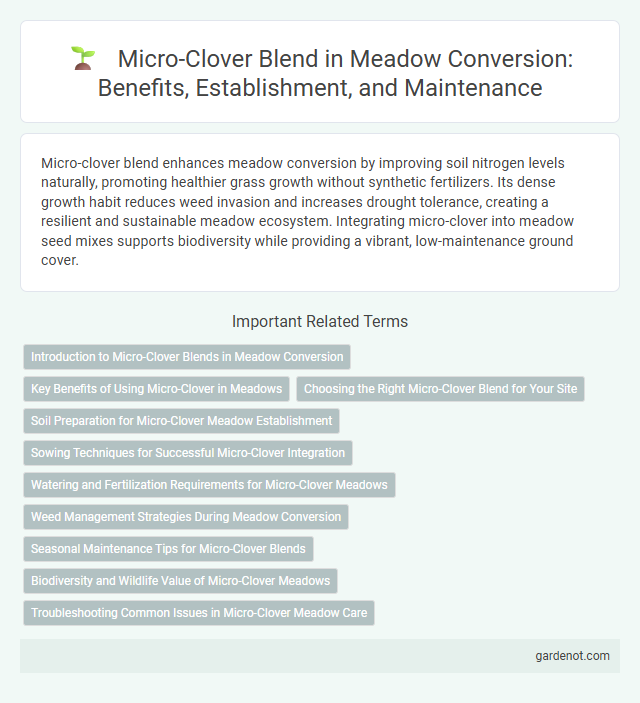Micro-clover blend enhances meadow conversion by improving soil nitrogen levels naturally, promoting healthier grass growth without synthetic fertilizers. Its dense growth habit reduces weed invasion and increases drought tolerance, creating a resilient and sustainable meadow ecosystem. Integrating micro-clover into meadow seed mixes supports biodiversity while providing a vibrant, low-maintenance ground cover.
Introduction to Micro-Clover Blends in Meadow Conversion
Micro-clover blends are increasingly favored in meadow conversion projects for their nitrogen-fixing properties and resilience during dry periods. Integrating micro-clover into meadow seed mixes enhances soil fertility naturally, reducing dependency on synthetic fertilizers and promoting sustainable growth. Its low-growing habit and shade tolerance improve ground cover, fostering biodiversity and robust meadow ecosystems.
Key Benefits of Using Micro-Clover in Meadows
Micro-clover blend enhances meadow biodiversity by improving soil nitrogen fixation, leading to healthier and more resilient plant growth. Its low-growing habit reduces mowing frequency and suppresses weed emergence, cutting maintenance costs. Micro-clover also supports pollinators by providing a rich source of nectar, boosting local ecosystem health and biodiversity.
Choosing the Right Micro-Clover Blend for Your Site
Selecting the right micro-clover blend for your meadow conversion depends on soil type, sunlight exposure, and moisture levels. Look for blends with varieties like Trifolium repens that are suited to your local climate and offer disease resistance and drought tolerance. Prioritize blends containing a mix of micro-clover with compatible grasses to enhance soil nitrogen fixation, improve ground cover, and reduce maintenance needs.
Soil Preparation for Micro-Clover Meadow Establishment
Effective soil preparation for micro-clover meadow establishment involves thorough soil testing to assess pH levels, ideally maintained between 6.0 and 7.0 to promote optimal nitrogen fixation. Incorporating organic matter enhances soil structure and moisture retention, providing a favorable environment for micro-clover root development. Proper seedbed preparation with fine, firm soil improves seed-to-soil contact, increasing germination rates and establishing a healthy micro-clover blend meadow.
Sowing Techniques for Successful Micro-Clover Integration
Sowing micro-clover blend requires precise soil preparation to ensure optimal seed-to-soil contact and enhance germination rates. Utilizing a fine, firm seedbed and broadcasting seeds evenly followed by light raking or rolling promotes uniform micro-clover establishment. Adjusting sowing rates to 250-400 seeds per square foot balances ground cover density while reducing competition with grasses in meadow conversion.
Watering and Fertilization Requirements for Micro-Clover Meadows
Micro-clover blends require minimal watering once established due to their drought-tolerant nature, reducing overall irrigation needs compared to traditional lawns. Fertilization demands are low; applying a balanced, slow-release fertilizer twice per growing season supports healthy growth without promoting excessive foliage. This low-input maintenance makes micro-clover meadows an eco-friendly choice for sustainable lawn conversion.
Weed Management Strategies During Meadow Conversion
Micro-clover blends enhance weed management during meadow conversion by outcompeting invasive species through dense ground cover and nitrogen fixation. This symbiotic relationship reduces weed establishment while improving soil fertility and promoting a healthier meadow ecosystem. Effective integration of micro-clover results in reduced reliance on herbicides and sustainable weed suppression.
Seasonal Maintenance Tips for Micro-Clover Blends
Micro-clover blends require consistent seasonal maintenance to promote dense growth and vibrant foliage throughout the year. Regular mowing at a height of 2-3 inches and timely fertilization with a balanced nitrogen-phosphorus-potassium (NPK) ratio enhances nitrogen fixation and supports healthy micro-clover development. Proper watering schedules, adjusted seasonally to prevent drought stress or waterlogging, ensure optimal root establishment and sustained green coverage.
Biodiversity and Wildlife Value of Micro-Clover Meadows
Micro-clover blend enhances biodiversity by creating a habitat rich in nectar and pollen, supporting a wide range of pollinators such as bees, butterflies, and hoverflies. The dense foliage and nitrogen-fixing properties improve soil health while providing shelter and food resources for small mammals, birds, and beneficial insects. Micro-clover meadows contribute to ecosystem stability by promoting a balanced environment that fosters wildlife diversity and resilience.
Troubleshooting Common Issues in Micro-Clover Meadow Care
Micro-clover blends can face challenges such as patchy growth and yellowing leaves due to inadequate soil drainage or improper mowing height. Address these issues by ensuring well-drained soil conditions and maintaining a consistent mowing height of around 2 to 3 inches to promote healthy growth. Regular soil testing and the application of balanced fertilizers can also prevent nutrient deficiencies that hinder micro-clover meadow vitality.
Micro-clover blend Infographic

 gardenot.com
gardenot.com